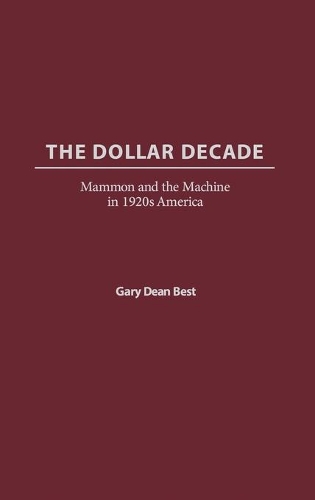
The Dollar Decade: Mammon and the Machine in 1920s America
(Hardback)
Publishing Details
The Dollar Decade: Mammon and the Machine in 1920s America
By (Author) Gary D. Best
Bloomsbury Publishing PLC
Praeger Publishers Inc
30th March 2003
United States
Classifications
General
Non Fiction
973.915
Physical Properties
Hardback
184
Description
This book examines the underlying causes of the tumult of the 1920s in America that has since captivated writers, readers, moviegoers, and television viewers. During the 1920s, Americans were aware of the momentous changes taking place in their lives. It was an introspective decade. Magazines and newspaper articles, books and anthologies explored the causes, nature, and implications of those changes. The impact of radio, and to a lesser extent motion pictures, rivaled the effects that the invention of printing had had on human society hundreds of years earlier. Add to these developments the effects of World War I and the popularization of Freud and Darwin, and the result was an America cast adrift on a sea of normlessness, treading water between two worlds: one of stability and tradition before the war, and one as yet dimly perceived in the mists of the future. While Freud challenged notions of traditional behavior, Darwin challenged traditional religious beliefs. The arrival of the affordable automobile transformed human mobility on a scale not seen since the domestication of the horse and the invention of the wheel thousands of years before. But those previous changes had not ushered in so many cataclysmic changes in so short a time. The author maintains that only in this context can much of the behavior of the time be understood, from the popularity of the Ku Klux Klan to the excesses of the flappers and the jazz age.
Reviews
[A] handy guide to many of the innovatioins of the 1920s, and the book's thesis that the machine influenced almost all of the major trends of the 1920s is thought-provoking. This is an intriguing concept, and, for this reason, gary Dean Best's book should be read and considered by anyone interested in why the decade became known as the New Era.-The Historian
"A handy guide to many of the innovatioins of the 1920s, and the book's thesis that the machine influenced almost all of the major trends of the 1920s is thought-provoking. This is an intriguing concept, and, for this reason, gary Dean Best's book should be read and considered by anyone interested in why the decade became known as the New Era."-The Historian
"[A] handy guide to many of the innovatioins of the 1920s, and the book's thesis that the machine influenced almost all of the major trends of the 1920s is thought-provoking. This is an intriguing concept, and, for this reason, gary Dean Best's book should be read and considered by anyone interested in why the decade became known as the New Era."-The Historian
Author Bio
GARY DEAN BEST is Professor Emeritus of History at the University of Hawaii, Hilo. His previous books include Pride, Prejudice, and Politics (Praeger, 1990), FDR and the Bonus Marchers (Praeger, 1992), The Nickel and Dime Decade (Praeger, 1993), and The Retreat from Liberalism (Praeger, 2002).
